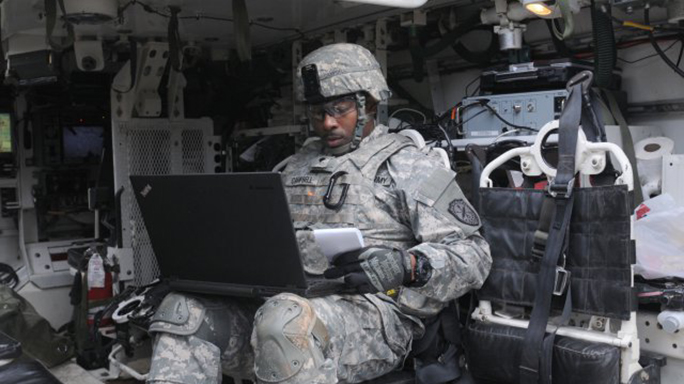The following is a release from Claire Heininger and the U.S. Army:
Situational awareness – knowing precisely what’s happening on the battlefield, where and when – can make the difference between mission success and mission failure.
Now, the Army wants to extend commanders’ situational awareness into cyberspace.
Advertisement — Continue Reading Below
“It is the Army’s number one gap to start to look to fill,” said Russ Fenton, of the U.S. Army Training and Doctrine Command’s, or TRADOC’s, Cyber Center of Excellence. “There is a list of cyber gaps, and at the top is situational awareness.”
To investigate new technology and solutions that could help tactical commanders visualize the cyber domain and calculate risk from cyber threats, the Army kicked off a Cyber Innovation Challenge with an industry day, Nov. 18.
- RELATED STORY: US Army Exploring Cyber Materiel Development Strategy
The innovation challenge looks to industry partners – especially non-traditional defense contractors – to deliver prototype solutions for rapid evaluation using a flexible acquisition model known as Other Transaction Authority.
Advertisement — Continue Reading Below
“Our priority on cyber is to figure out how to make acquisition responsive to the requirements,” said Kevin Fahey, executive director for System of Systems Engineering and Integration, Office of the Assistant Secretary of the Army for Acquisition, Logistics and Technology, or ASA(ALT). “In this space, the best thing we can do is get it in the hands of users.”
The innovation challenge does just that by working through a consortium of industry, academia and government entities, which allows the Army to solicit, evaluate and purchase limited quantity prototypes of equipment from a wide range of non-traditional sources. These prototypes are then placed in the hands of cyber Soldiers for operational evaluation to inform specifications prior to fielding decisions and potential broader procurement.
The Army’s inaugural challenge, which focused on deployable kits for cyber protection teams executing defensive cyber operations, was recently conducted from June to September and resulted in Other Transaction, or OT, agreements with two vendors to deliver prototype equipment.
Advertisement — Continue Reading Below
“Going through this process is fast,” Fahey said. “It really did work – we got responsiveness to our requirements and we saw a lot of innovation.”
For the situational awareness challenge, the Army plans to release a requirements synopsis to industry for white papers in December, conduct an initial down-select in January 2016, evaluate technologies in a lab setting in March, and award potential OT agreements in April.
The industry day – attended by approximately 200 people representing a wide range of micro, small and large companies – set the stage by outlining the scope and parameters of the Cyber Innovation Challenge framework, as focusing on a piece of the Army’s larger cyber situational awareness requirement.
Advertisement — Continue Reading Below
While sensors, data feeds, data storage, analytics, visualization and planning tools are all important components of that requirement, the challenge focuses specifically on ways to measure and depict cyber risk for tactical commanders, Fenton said.
Officials with TRADOC and Army Cyber Command, or ARCYBER, provided visuals and demonstrations of notional versions of potential tools that would scan a wealth of information sources, crunch millions of lines of data to identify cyber threats, and deliver a risk assessment to commanders through a customizable interface overlaid with detailed battlefield maps.
- RELATED STORY: Army’s Cyber Protection Team Testing Capabilities
“An analyst can visualize key metrics in specific time periods,” said Maj. Isaac Faber, a data scientist with ARCYBER, who developed a notional tool for the discussion. “You can get beyond [security] patch status and other metrics to form a meaningful and actionable score for the commander.”
Advertisement — Continue Reading Below
Along with earning potential OT agreements, solutions demonstrated during the innovation challenge could also feed into CyberQuest, a TRADOC exercise beginning next year that will examine priority Army cyber requirements and relevant capabilities in an experimental environment. Eventually, the Army’s goal is to hold three to four Cyber Innovation Challenges per year to help investigate priority requirements and to feed into CyberQuest.
“We’re trying to inform requirements and inform materiel solutions,” Col. Bryan J. Stephens, director of the ASA(ALT) Cyber Focal, told industry partners. “We’re looking for feedback on whether we’re headed down the right path – help us shape it.”
























